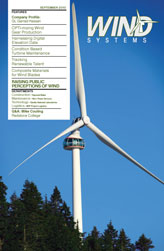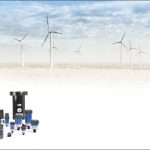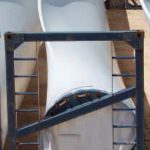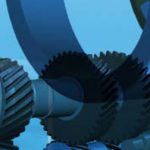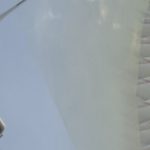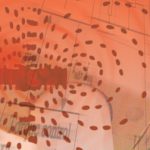The cornfields around Yorktown, Indiana—about 40 miles from Indianapolis—are among the most fertile found anywhere in the United States. It’s also the perfect environment for cultivating another kind of business, so it’s here that Brevini Wind USA has set down deep roots with a $50-million, 100,000 square-foot ultramodern facility featuring North America’s only 6.4 MW test bench for the production of main gearboxes for 0.9 to 3.5 MW wind turbines. This, of course, is the size range typically found in most of today’s land-based applications in the region. If you think that Brevini Wind is “betting the farm” on the U.S. wind power market, you’d be right. After all, wind turbine deployments in North America are expected to exceed 40,000 units between 2010 and 2015. While Europe dominated the world market for wind turbines five years ago with 70 percent of new capacity, today the U.S. and China account for 62 percent of new capacity, with Europe following at 27 percent.
Beginning in November of this year the new facility will offer many advantages to wind turbine customers seeking to penetrate the booming North American marketplace, according to Managing Director Dr. Jacopo Tozzi. “Most of the major wind turbine manufacturers are based in Europe, so the logistical benefits of sourcing gearboxes ‘locally’ through Brevini Wind USA will be significant for them going forward,” he says. “We are already seeing evidence of this, in fact, with a large order from Finnish wind turbine manufacturer WinWinD for their 3MW wind turbines.”
The gears for WinWinD’s gearboxes, and Brevini Wind’s other customers, will all be produced by Gleason machines employing new technologies that simply didn’t exist a year or two ago. Tozzi believes that his company’s investment in these new Gleason technologies and processes will help the company to quickly become a major player in the production of a new generation of highly reliable, lightweight, and efficient wind power main gearboxes, giving the company a decided competitive advantage going forward. “Brevini Group, and the Brevini Power Transmission division in particular, is no stranger to wind power, having produced some 60,000 pitch and yaw systems for wind turbines over the years,” Tozzi explains. “Our division, Brevini Wind, was established two years ago in order to concentrate on the design, development, testing, and manufacture of main gearboxes for wind turbine applications. This, of course, is one of the most challenging applications for gears, given the high and dynamic loads and the need for extreme reliability. In order to better understand how our competition was meeting these challenges I had the opportunity to tour many of their plants in Europe, China, and India. Almost without exception, the machines they were using for gear production were made by Gleason.”
By November two new Gleason profile grinding machines—models P1600G and P2400G—and two Gleason hobbing machines, models P1600 and P2400, will be up and running at the Brevini Wind USA facility, producing all of the gears found in a series of new generation two-stage planetary gearboxes. These include ring gears with diameters as large as 2.2 meters and accuracy requirements as high as ISO Grade 6 or better, and smaller gears of ISO Grade 5 or better. These classifications are typical of gears for wind turbine applications, although the Gleason profile grinders can actually deliver even ISO Grade 3 or better, if required.
These new planetary gearboxes can produce reduction ratios of up to 37:1 with up to 98 percent efficiency, while at the same time reducing overall size and weight by 25 percent as compared to competitive models. But perhaps most importantly, Brevini Wind will gain an enormous competitive advantage by producing these gears much faster, more accurately, and using fewer machines thanks to a revolutionary new Gleason hard finish grinding process called OPTI-GRIND™. Available only on the latest generation of Gleason profile grinding machines, OPTI-GRIND will enable Brevini Wind to cut precious minutes and even hours out of the time typically needed to profile grind one of its large gears, since productivity gains of up to 40 percent are possible as compared to grinding conventionally. In addition, OPTI-GRIND also can be used to deliver surface finishes better than 0.2 microns; a finish two to three times the level that is generally achievable with profile grinding alone, and so accurate that no additional processes are required after grinding.
According to Gleason Director of Product Management, Grinding Solutions, Dr. Antoine Türich, for the first time OPTI-GRIND solves the dilemma that every gear manufacturer faces: how to achieve, with optimum efficiency, both highly desirable productivity gains and exceptional accuracies. “Wind power gear manufacturers can of course achieve high productivity by using a coarse-grit grinding wheel that will remove a sufficient amount of material when roughing, but these won’t deliver the required fine surface finishes,” Türich explains. “Conversely, a fine-grit wheel can be used to produce an excellent surface finish, but at the expense of productivity. As a result, grinding wheels are generally used that are a compromise solution, delivering reasonable levels of productivity and accuracy, but well below optimum levels. But with OPTI-GRIND we can achieve both optimum productivity and surface finishes by simultaneously using multiple dressable grinding wheels for profile grinding rather than just the single ‘compromise’ grinding wheel typically used.”
The new process offers end users like Brevini Wind a number of variations to choose from to meet their specific applications. When optimum productivity is desirable, for example, an assembly of three dressable wheels is used to rough grind four tooth flanks simultaneously, as compared to the typical process of a single wheel roughing only two tooth flanks at once (Figure 1). OPTI-GRIND then is used to finish grind conventionally using just the single center wheel, which has been dressed to produce the desired surface finish and flank modifications.
For planetary gears and pinions, an OPTI-GRIND variation using the two outer wheels alone is available, with each grinding a flank on separate gear teeth simultaneously (Figure 2). This variation reduces the radial infeed required as compared to grinding conventionally with a single wheel. OPTI-GRIND provides a wheel orientation that optimizes the contact angles between the grinding wheel and workpiece flank. This variation offers the largest benefit for pinion type gears because of their substantial profile angle variation from tooth tip to the tooth root.
In applications requiring maximum surface finish quality, a third variation is available. As shown in Figure 3, OPTI-GRIND uses two outer wheels with an aggressive grit size to each rough grind a flank on separate gear teeth, before a middle wheel with extremely fine grit size finishes the left and right flanks.
“It’s important to note that OPTI-GRIND uses dressable wheels for fine finishing rather than the non-dressable CBN wheels used in previous multiple-wheel profile grinding techniques. With OPTI-GRIND we give users the flexibility to produce a variety of highly desirable tooth modifications, including grinding of the root without burning,” Türich says, noting that on the Gleason profile grinders the dressing unit is actually integral to the grinding head, a unique design that helps to reduce dressing times and improve accuracy and repeatability. Figure 4
Brevini Wind also hopes to gain yet another edge on its competition by optimizing its “soft” cutting operations as well, with a new Gleason hob design called OPTI-CUT®. Unlike the solid HHS cutters normally used for large gear hobbing, the OPTI-CUT family of roughing and finishing hobs, as well as gear gashers and shaper cutters, are very high quality assemblies consisting of either five or six cutter body segments and utilizing the latest replaceable, indexable carbide insert technology. Figure 5 By using a cutter with the latest carbide materials, coatings, and cutting geometries, Brevini Wind will be able to run its two new Gleason hobbers at significantly higher feeds and speeds—for both external and internal gears—and even cut dry, helping to make significant reductions in total cost per workpiece.Other benefits include more-consistent tool life and surface finishes, while at the same time eliminating the time and expense needed for resharpening and recoating a conventional solid cutter.
“Launching a company to produce main gearboxes for today’s wind turbines is not something that can be done easily or quickly,” according to Tozzi (Figure 6). “We have spent a number of years laying the groundwork with the right team of people, and a significant investment in new technologies and processes, with the new Gleason machines being among the most important of these. Now we are poised to help customers take advantage of the enormous potential that exists today and tomorrow in wind power throughout North America.”



















